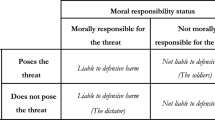Abstract
The use of child soldiers in armed conflict is an increasing global concern. Although philosophers have examined whether child soldiers can be considered combatants in war, much less attention has been paid to their moral responsibility. While it is tempting to think of them as having diminished or limited responsibility, child soldiers often report feeling guilt for the wrongs they commit. Here I argue that their feelings of guilt are both intelligible and morally appropriate. The feelings of guilt that child soldiers experience are not self-censure; rather their guilt arises from their attempts to come to terms with what they see as their own morally ambiguous motives. Their guilt is appropriate because it reaffirms their commitment to morality and facilitates their self-forgiveness.
Similar content being viewed by others
Notes
Although the exact number is difficult to determine, in the late 1990s and early 2000s, it was estimated that there were between 250,000 and 300,000 child soldiers worldwide.
Let me be clear that I am setting aside any questions about the extent to which child soldiers should be held legally responsible for the violence. I do not intend my arguments to support any recommendations about the possibility of punishing child soldiers. My arguments are moral, not legal; they are only meant to apply to the kinds of emotions child soldiers do and should experience.
This example is similar to Prinz’s (2004).
There is a complex discussion in the literature on emotions about whether intelligible emotions involve judgments, beliefs, or perceptions. These disagreements are subspecies of the cognitivist/non-cognitivist debates about emotions. I wish to remain agnostic about this debate. The notion of fit or intelligibility that I am appealing to could be compatible with either a cognitivist or a non-cognitivist account. Taylor (1985), Roberts (1988), Gibbard (1990), Greenspan (1992), Wallace (1994), D’Arms and Jacobson (2000, 2003), Prinz (2004), Raikka (2005), and Brady (2008) all address this debate to varying degrees in their accounts.
Rawls is often cited as the primary advocated of this definition (2003).
Recalcitrant (or irrational)
There are less clear cases, such as survivor’s guilt, but these cases are controversial precisely because we do not understand how the agent sees herself as connected to the wrong done. Survivor’s guilt is puzzling because we are unsure what the agent feels guilty for. It does not follow that survivor’s guilt is thus irrational. It only means that we must treat it as a special case. Greenspan addresses survivor’s guilt specifically (1992).
Darwall, for example, writes, “To feel guilt, consequently, is to feel as it one has the requisite capacity and standing to be addressed as responsible” (2006, 71). Gibbard says that guilt is “tied to the voluntary” (1990, 99). Likewise Taylor claims, “It is true to say that when feeling guilty…I must think myself responsible for the relevant state of affairs” (1985, 91). Taylor, however, envisions responsibility widely to include cases of causal responsibility (1985).
“[Child soldiers] are not robots who passively adopt the rhetoric and morals of the armed groups the live within” (Wessells 2006, 144). “Well aware that they have committed wrongs in the eyes of their community and society, many young people who have killed in war do experience and sense of shame or remorse and many yearn for forgiveness” (Boyden 2006, 356).
“This continuous dynamic of inflicting and withholding pain…puts the victim in the unavoidable position of betraying or colluding against himself, an experience the victim undergoes whether or not he actually informs or confesses” (Sussman 2005, 24).
For this distinction, see Thomason (2015).
La Caze makes this argument about envy (La Caze 2001).
Greenspan provides an example from Russell’s autobiography in which he breaks a promise to a woman with whom he was in love. He describes himself as feeling “sorrow for this tragedy” (Greenspan 1995, 116).
References
Beah I (2008) A long way gone: memoirs of a boy soldier. Sarah Crichton Books, New York
Blustein J (2000) On taking responsibility for one’s past. J Appl Phil 17:1–19
Boyden J (2003) The moral development of child soldiers: what do adults have to fear? Peace Confl: J Peace Psych 18:343–362
Brady M (2008) The irrationality of recalcitrant emotions. Philipp Studies 145:413–430
Breen C (2007) When is a child not a child? Child soldiers in international law. Hum Rights Rev 8(2):71–103
D’Arms J, Jacobson D (2000) The moralistic fallacy: on the ‘appropriateness’ of emotions. Philos Phenomenol Res 61:65–90
D’Arms J, Jacobson D (2003) The significance of recalcitrant emotions. In: Hatzimoysis A (ed) Philosophy and the emotions. Cambridge University Press, Cambridge
Darwall S (2006) The second-person standpoint. Harvard University Press, Cambridge
Dillon R (2001) Self-forgiveness and self-respect. Ethics 112:53–83
Fisher K (2013) Transitional justice for child soldiers: accountability and social reconstruction in post-conflict contexts. Palgrave MacMillan, New York
Frankfurt H (1988) The importance of what we care about. Cambridge University Press, Cambridge
Gade EK (2010) Defining non-combatants: how do we determine who is worthy of protection in violent conflict? J Mil Ethics 10(4):219–242
Gibbard A (1990) Wise choices, apt feelings. Harvard University Press, Cambridge
Glatzer, J (2003) The flute player. Over the Moon Productions, Los Angeles, CA DVD
Greenspan P (1992) Subjective guilt and responsibility. Mind 101:287–303
Greenspan P (1994) Guilt and virtue. J Philipp 9:57–70
Greenspan P (1995) Practical guilt: moral dilemmas, emotions, and social norms. Oxford University Press, Oxford
Griswold C (2007) Forgiveness: a philosophical exploration. Cambridge University Press, Cambridge
Holmgren M (1998) Self-forgiveness and responsible moral agency. J Value Inq 32:76–91
Hyman J (2013) Voluntariness and choice. Philos Q 63:683–708
Korsgaard C (1996) Creating the kingdom of ends. Cambridge University Press, Cambridge
La Caze M (2001) Envy and resentment. Philos Explor 4:31–45
Litz B, Stein N, Delaney E, Lebowitz L, Nash W, Silva C, Maguen S (2009) Moral injury and moral repair in war veterans: a preliminary model and intervention strategy. Clin Psychol Rev 29:695–706. doi:10.1016/j.cpr.2009.07.003
McMahan J (2009) An ethical perspective on child soldiers. In: Gates S, Reich S (eds) Child soldiers in the age of fractured states. University of Pittsburgh Press, Pittsburgh
Murphy J (1999) Shame creeps through guilt and feels like retribution. Law Philos 18:327–344
Murphy J (2003) Getting even: forgiveness and its limits. Oxford University Press, Oxford
O’Neill O (1989) Constructions of reason: explorations of Kant’s practical philosophy. Cambridge University Press, Cambridge
Pallikkathayil J (2011) The possibility of choice: three accounts of the problem with coercion. Philosopher’s Imprint 11:1–20
Pran D (1997) Children of Cambodia’s killing fields: memoirs by survivors. Yale University Press, New Haven
Prinz J (2004) Gut reactions: a perceptual theory of emotion. Oxford University Press, New York
Raikka J (2005) On irrational guilt. Ethical Theory Moral Pract 2:473–485
Rawls J (2003) A theory of justice. Harvard University Press, Cambridge
Roberts RC (1988) What an emotion is: a sketch. Philos Rev 97:183–209
Singer PW (2005) Children at war. Pantheon Books, New York
Smith A (2007) On being and holding responsible. J Ethics 11:465–484
Strawson P (2003) Freedom and resentment. In: Watson G (ed) Free will. Oxford University Press, Oxford
Sussman D (2005) What is wrong with torture? Philos Publ Aff 33:1–33
Taylor G (1985) Pride, shame, and guilt. Oxford University Press, New York
Thomason K (2015) The moral value of envy. South J Philos 53:36–53
Vaha ME (2011) Child soldiers and killing in self-defense: challenges to the moral view on killing in war. J Mil Ethics 10(1):36–51
Velleman JD (2003) Don’t worry, feel guilty. R Inst Philos Suppl 52:235–248
Wainryb C (2011) And so they ordered me to kill a person: conceptualizing the impacts of child soldiers and the development of moral agency. Hum Dev 54:273–300
Wallace RJ (1994) Responsibility and the moral sentiments. Harvard University Press, Cambridge
Wertheimer A (1987) Coercion. Princeton University Press, Princeton
Wessells M (2006) Child soldiers: from violence to protection. Harvard University Press, Cambridge
Wessells M, Kostelny K (2008) Youth soldiering: an integrated framework for understanding psychological impact. In: Barber B (ed) Adolescents and war: how youth deal with political violence. Oxford University Press, Oxford, pp 105–122
Williams B (1993) Shame and necessity. University of California Press, Berkeley
Wolf S (2004) The moral of moral luck. In: Calhoun C (ed) Setting the moral compass: essays by women philosophers. Oxford University Press, Oxford
Acknowledgments
I am grateful to Owen Ware and Aly Passanante for their comments on earlier versions of this paper. I am also grateful to the anonymous reviewers at Ethical Theory and Moral Practice for their helpful feedback and suggestions.
Author information
Authors and Affiliations
Corresponding author
Rights and permissions
About this article
Cite this article
Thomason, K.K. Guilt and Child Soldiers. Ethic Theory Moral Prac 19, 115–127 (2016). https://doi.org/10.1007/s10677-015-9595-3
Accepted:
Published:
Issue Date:
DOI: https://doi.org/10.1007/s10677-015-9595-3




